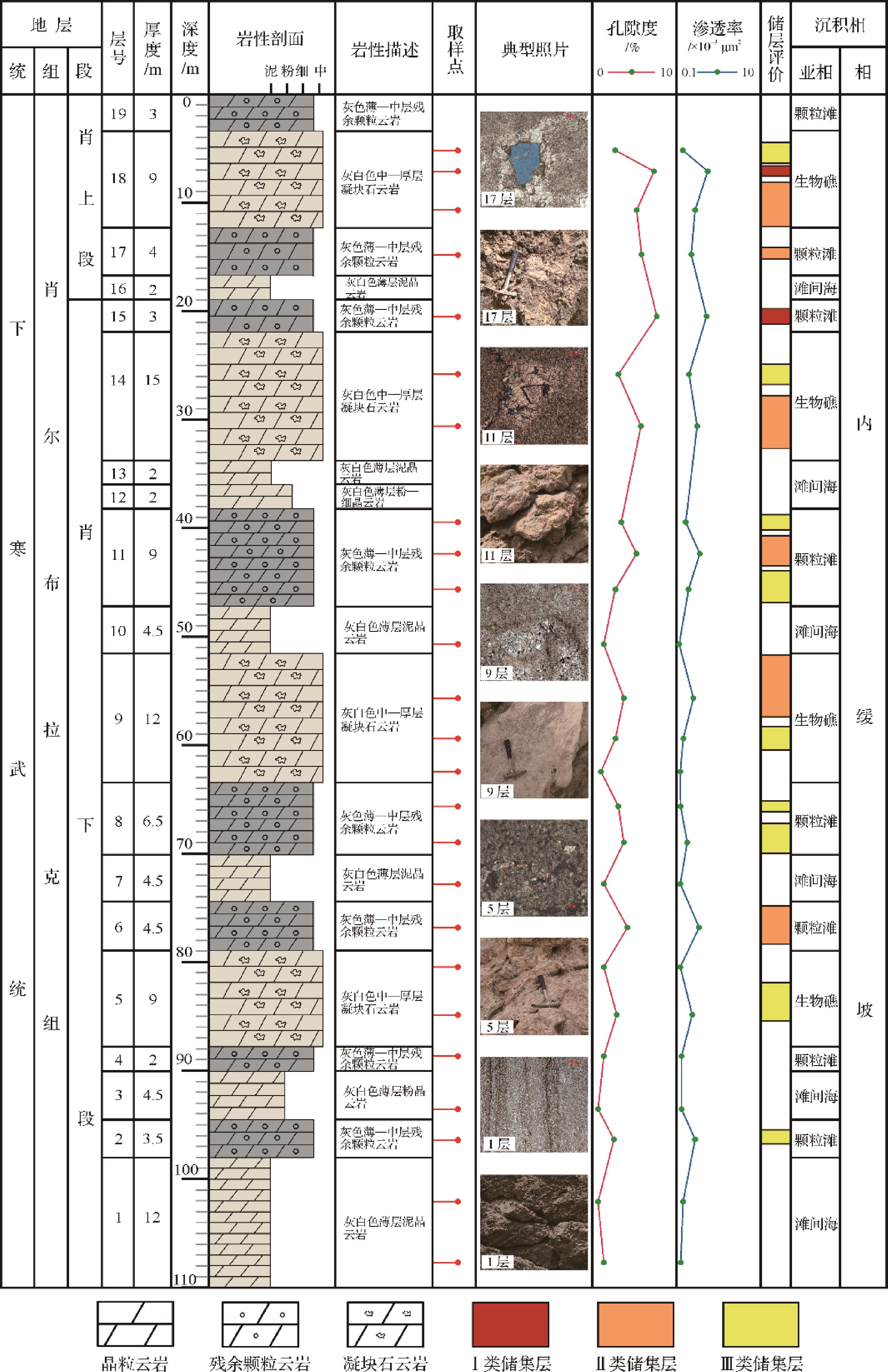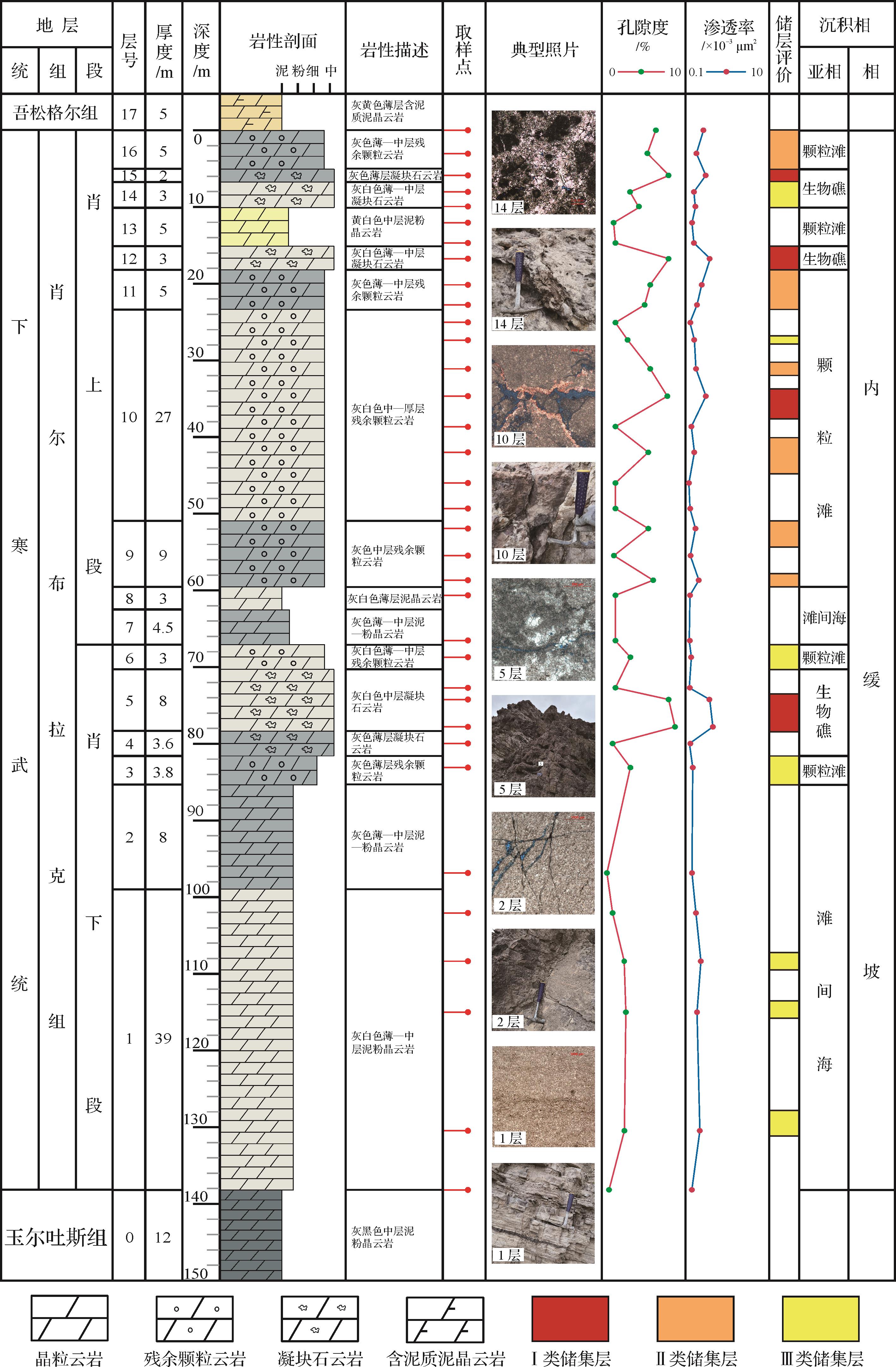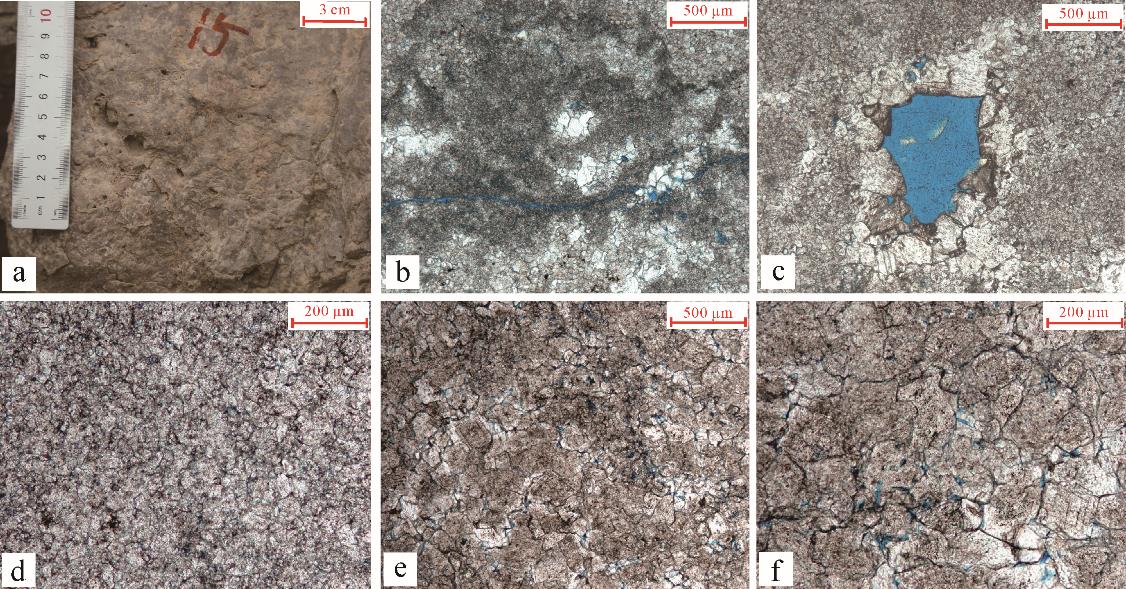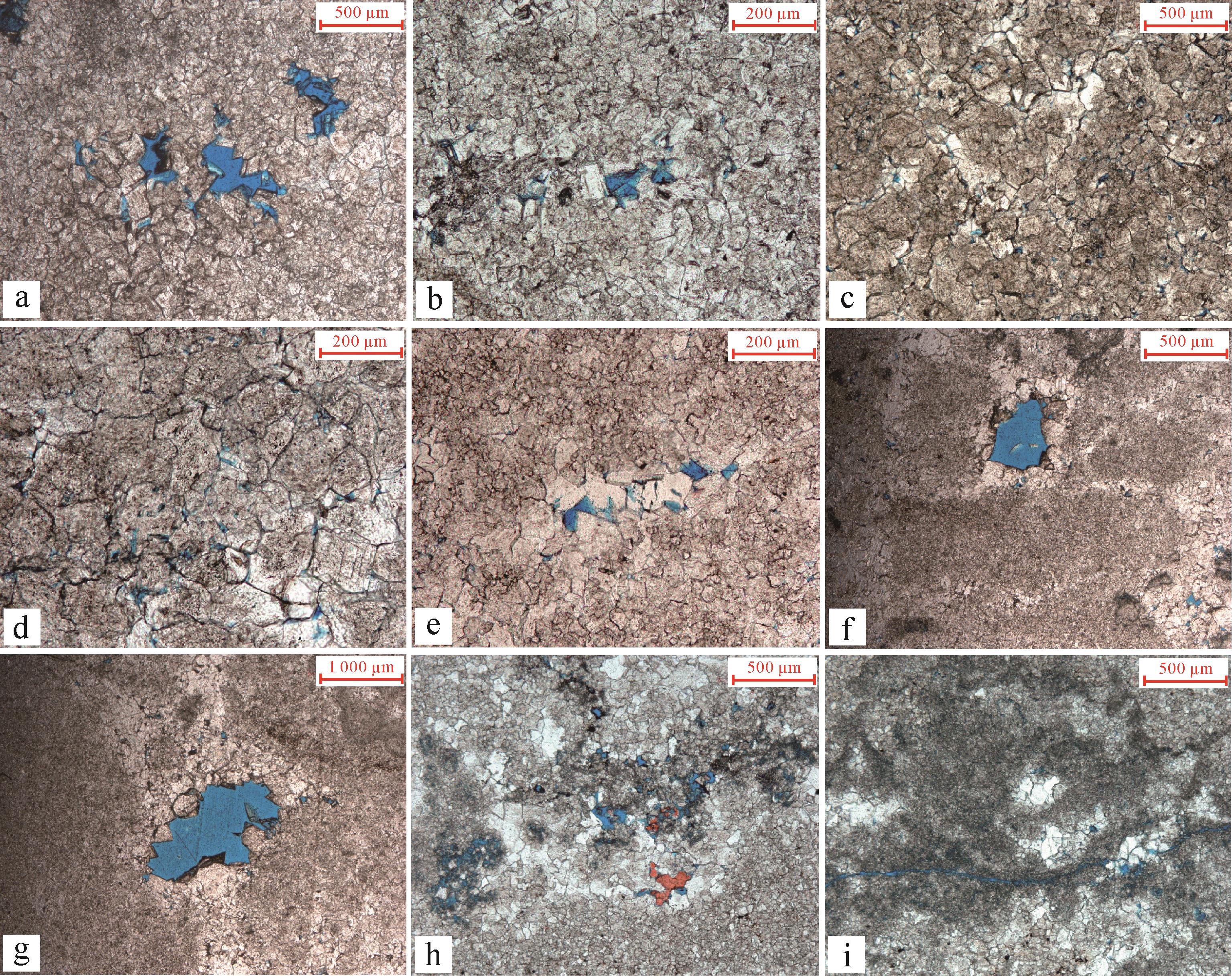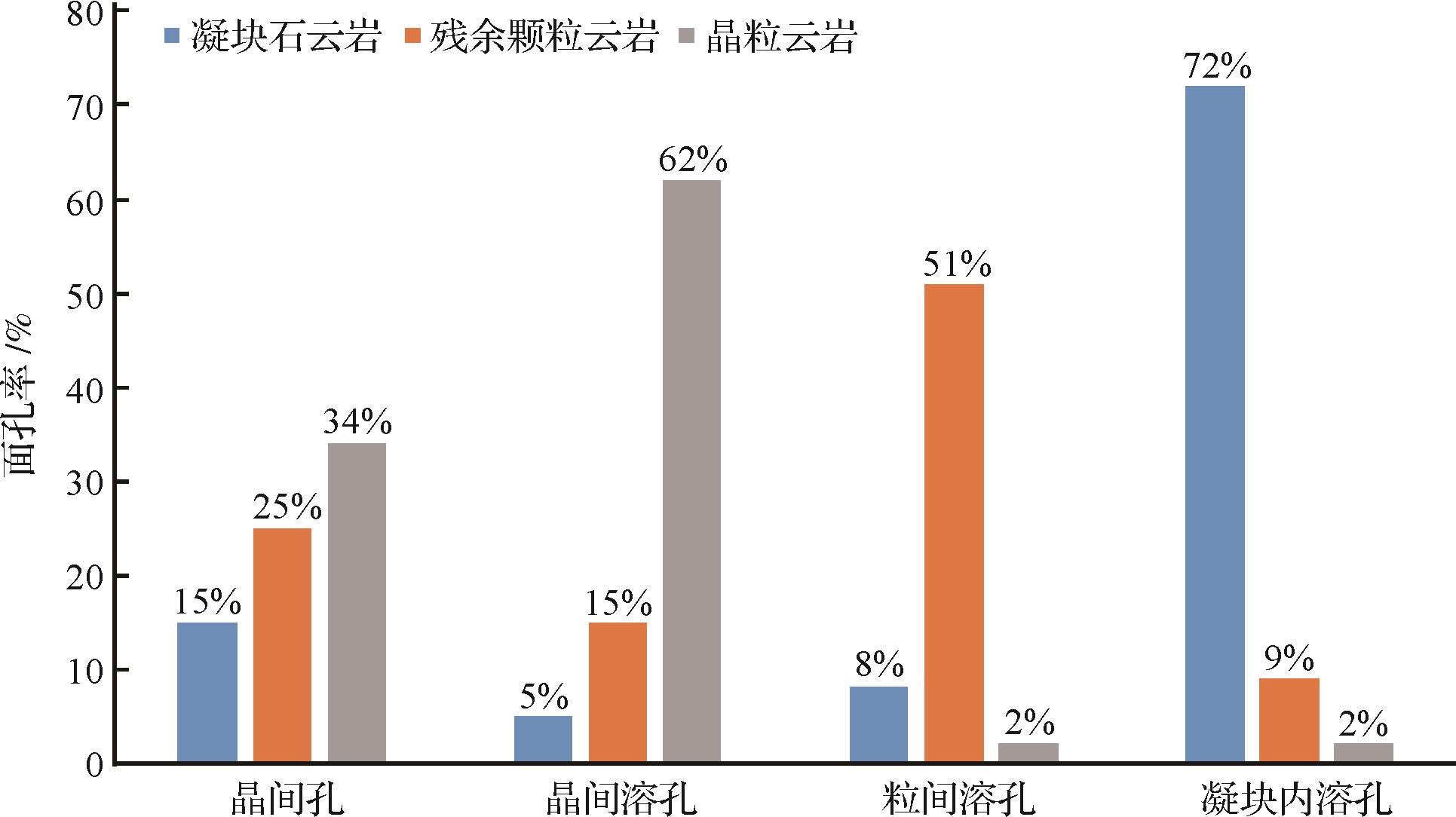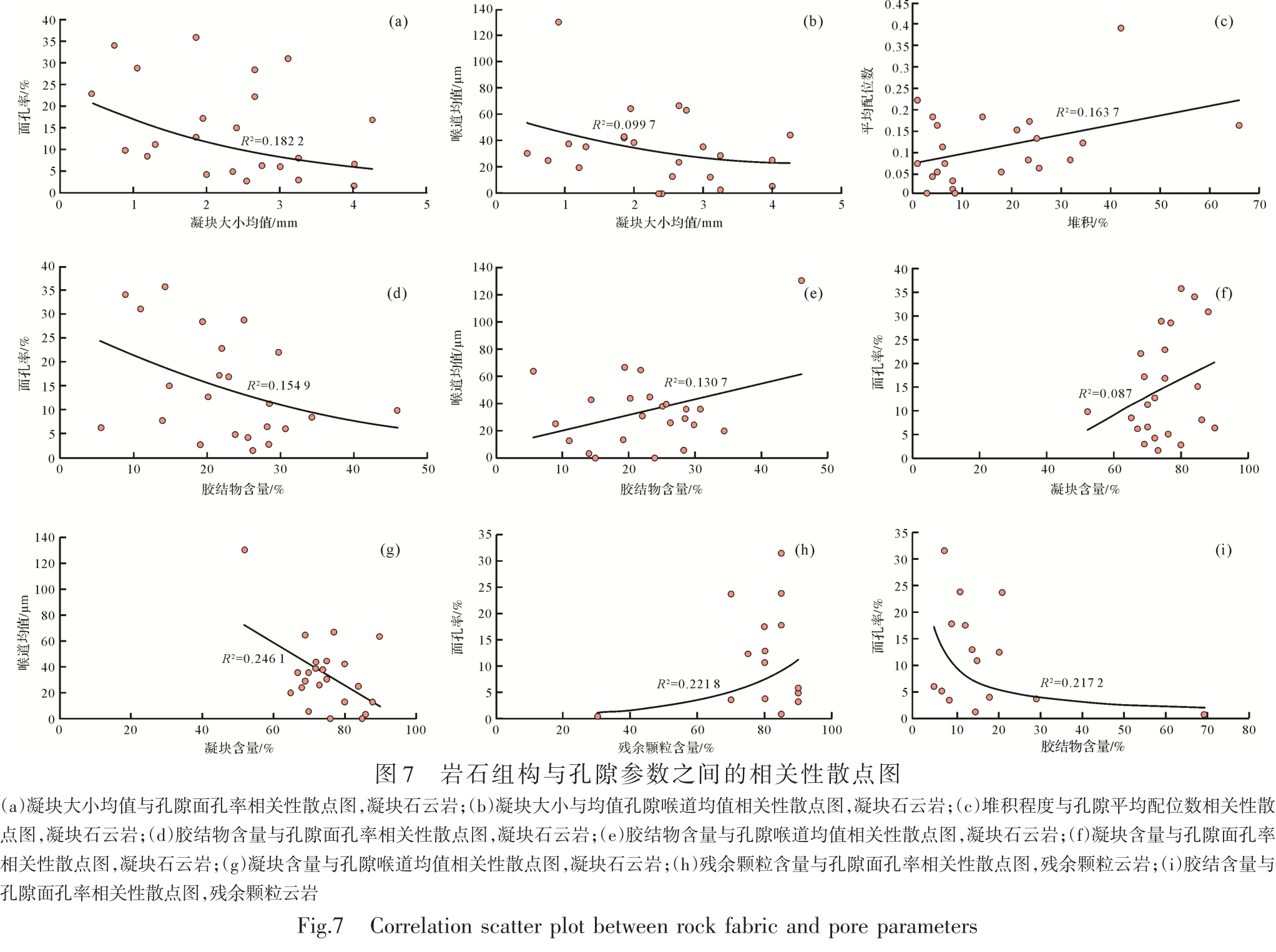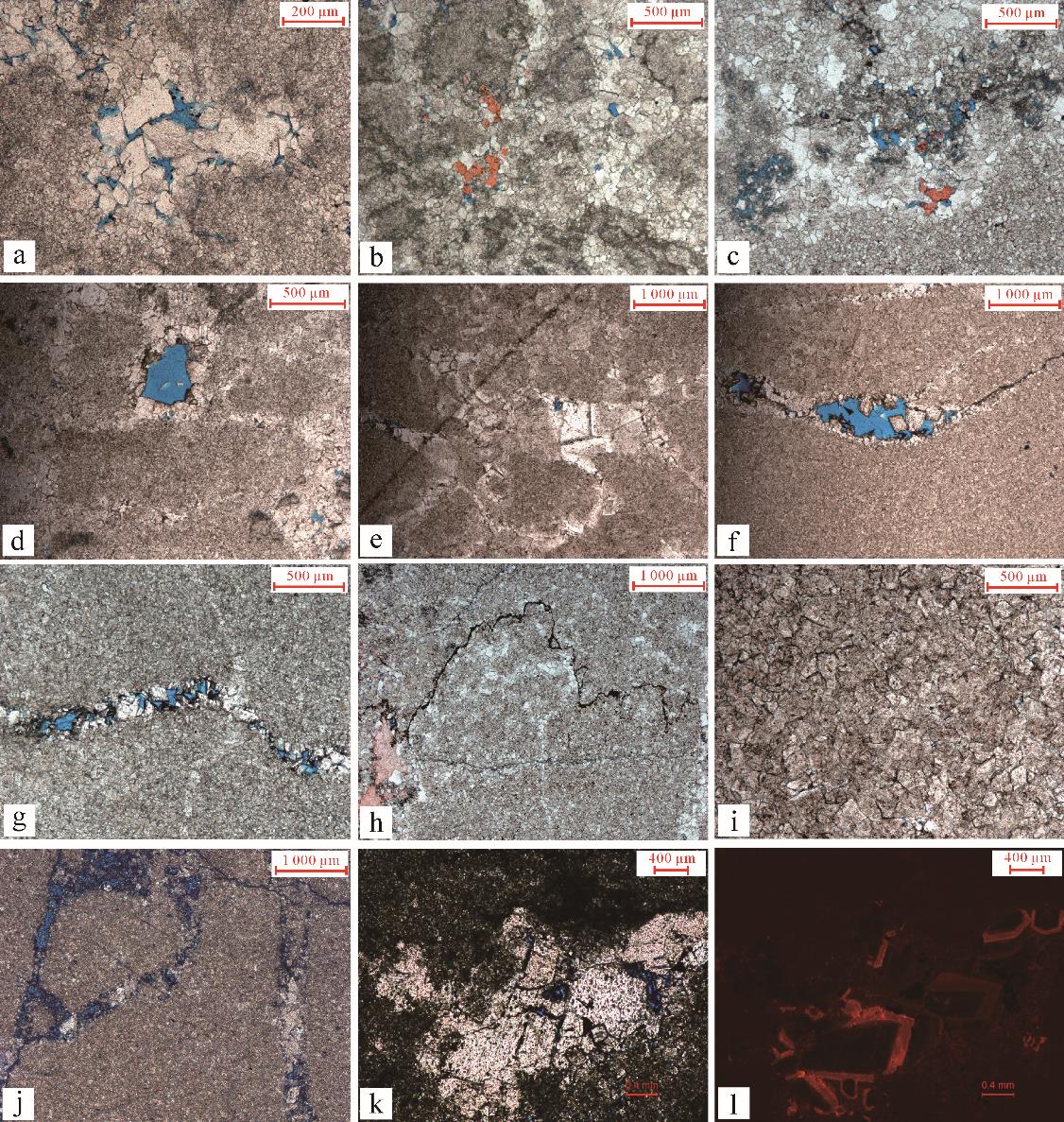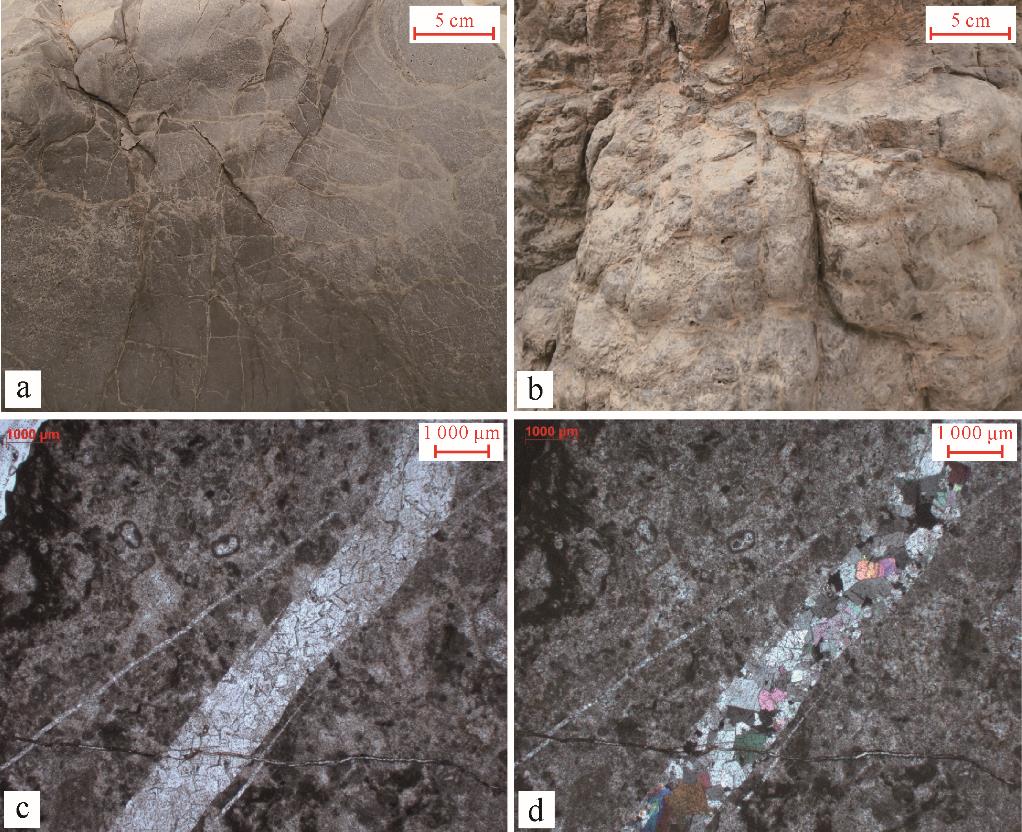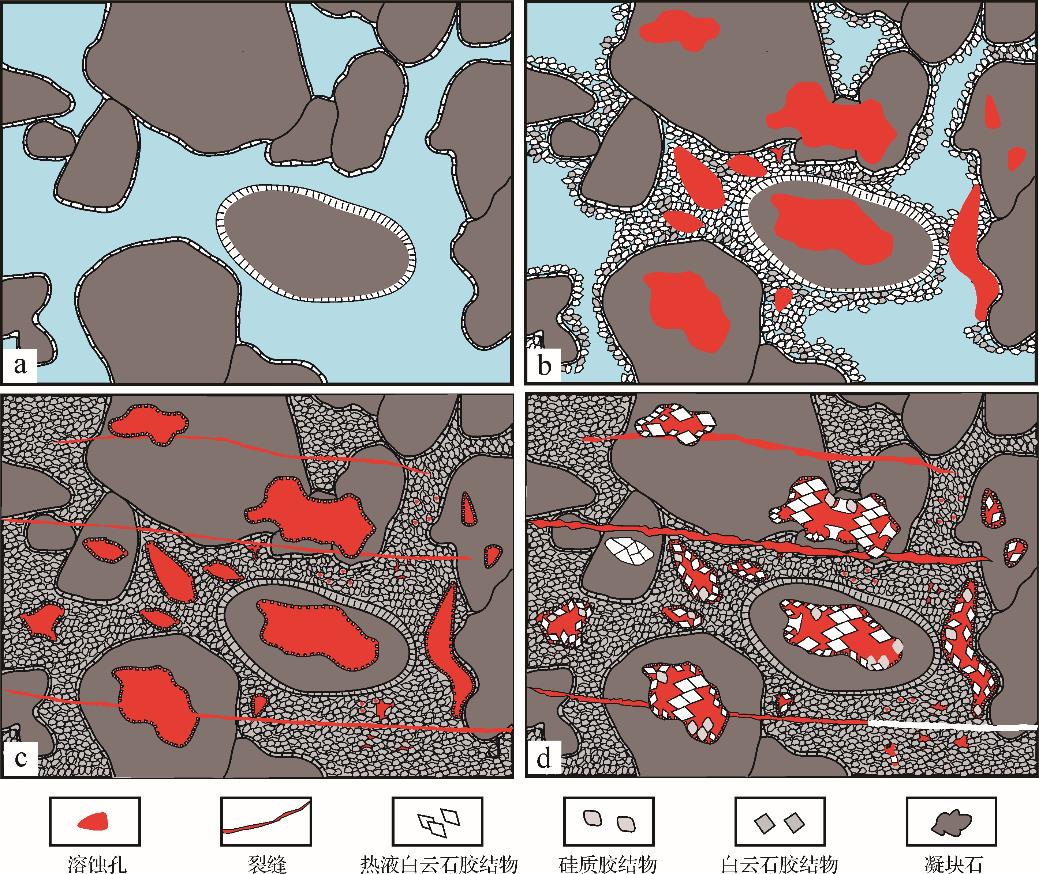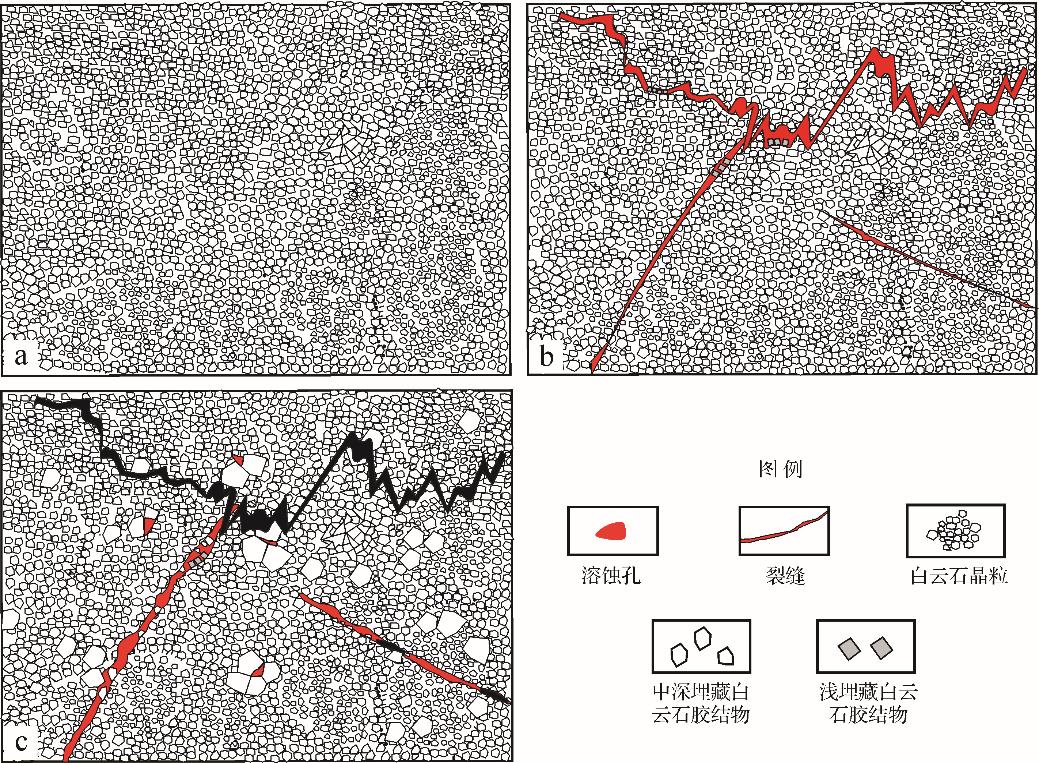HTML
-
白云岩储集层是海相含油气盆地的主要储层之一[1]。阿克苏地区的下古生界主要由白云岩组成,厚达数千米[2⁃8]。有学者通过对阿克苏地区苏盖特布拉克等露头剖面的研究,指出肖尔布拉克组白云岩类型主要为细—泥粉晶云岩、残余颗粒云岩以及部分残余凝块石云岩[9];孔隙类型包括溶孔、溶洞、晶间孔、晶间溶孔、粒间溶孔等,孔隙成因主要有沉积作用、白云石化作用、构造作用和岩溶作用等[10⁃12]; 2013年,中国石油塔里木油田分公司通过对中深1C井肖尔布拉克组的试油,使得寒武系盐下白云岩较好的储集潜力得到证实[13]。但由于井下岩心资料有限,针对该组不同白云岩中孔隙特征、成因的对比分析,仍不够深入。本文以肖西沟与苏盖特布拉克两个典型剖面为例,针对孔隙发育的白云岩段,按照不同的岩性分类开展孔隙特征研究,明确该地区不同类型的白云岩孔隙发育特征、成因及演化过程,以期对油气勘探开发提供一定的理论指导。
-
塔里木盆地位于天山、昆仑山和阿尔金山之间,是一个由古生代克拉通盆地和中、新生代前陆盆地叠加而成的复合盆地,盆地中心为塔克拉玛干沙漠[14⁃17]。阿克苏地区位于塔里木盆地西北缘,居于塔北古陆和塔南隆起之间,包括柯坪凸起和温宿凸起两个单元,为古隆起背景下的古冲断带[18⁃19]。区内寒武系出露齐全,自下而上地层分别为玉尔吐斯组(Є1y)、肖尔布拉克组(Є1x)、吾松格尔组(Є1w)、沙依里克组(Є2s)、阿瓦塔格组(Є2a)、丘里塔格组(Є3q)[20⁃22]。肖尔布拉克组岩性以白云岩为主,具体可细分为凝块石云岩、残余颗粒云岩、泥-细晶云岩等,厚度达204 m[23⁃25]。塔里木盆地早寒武世具有南北两高隆夹北东—南西向低坳的沉积地貌特征,控制着肖尔布拉克组沉积期 “三隆两坳” 古地理格局,进而控制了肖尔布拉克组碳酸盐岩缓坡沉积体系的发育,导致其沿古隆起向盆地依次发育混积坪、内缓坡(泥)云坪、内缓坡丘滩和台洼、内缓坡外带及外缓坡/盆地等5种沉积相带,其中研究区处于内缓坡相带[26⁃28](图1)。

Figure 1. Sedimentary facies plane map of the Lower Cambrian Xiaoerbulak Formation and the Cambrian stratigraphic histogram in Tarim Basin[26]
-
依据露头观察描述及薄片鉴定,阿克苏地区下寒武统肖尔布拉克组白云岩类型主要为凝块石云岩、(残余)颗粒云岩、晶粒云岩3大类。并结合孔渗数据建立肖西沟剖面和苏盖特布拉克剖面肖尔布拉克组的沉积—储层柱状图(图2,3)。

Figure 2. Sedimentary⁃reservoir histogram for the lower member of the Xiaoerbulak Formation in the Xiaoxigou section
(1) 凝块石云岩
通常呈浅灰色—灰色、厚层—块状产出,局部发育层状孔洞,部分凝块石在野外露头剖面上显示出不规则斑状特征。在显微镜下可见斑块状凝块,主要由不规则的钙化微生物凝块以及凝块间的亮晶白云石充填物组成,凝块部分颜色较深,凝块周围为泥粉晶白云石,凝块间孔洞被后期细—中晶白云石全充填或部分充填(图4a,b)。
(2) 残余颗粒云岩
通常呈浅灰色—灰白色,中—厚层状产出,局部发育溶蚀孔洞,呈不规则分布特征。在镜下可见残余颗粒主要为砂屑,含量大于75%,颗粒直径多为1~3 mm。残余颗粒受到较强的白云石化等成岩作用,镜下常隐约观察到砂屑的残余幻影结构。颗粒间孔隙多被后期胶结作用形成的白云岩全充填或部分充填(图4c)。
(3) 晶粒云岩
常呈棕色—深棕色,薄—中层状产出,局部出现厚层状产出。镜下晶粒结构明显,晶粒粒径范围为0.05~0.5 mm,即可识别出粉晶云岩、细晶云岩与中晶云岩。重结晶现象较发育,偶见缝合线发育,充填沥青等。孔隙及裂缝等常充填自形程度较好的细晶白云石(图4d~f)。
-
依据铸体薄片中孔隙的观察与统计,阿克苏地区肖尔布拉克组中孔隙类型包括原生孔隙、次生孔隙两类共4种类型(表1)。原生孔隙有晶间孔,次生孔隙有晶间溶孔、粒间溶孔、凝块内溶孔。具体特征如下:1)晶间孔,指晶粒云岩中矿物晶体之间的孔隙,薄片观察其直径介于0.5~3 mm(图5a~d)。2)晶间溶孔,由溶解作用形成的晶粒之间的孔隙(包括原有的晶间孔的溶解扩大)称为晶间溶孔,薄片观察其直径一般为1 mm,少数大于3 mm,主要可见因溶蚀作用而导致晶粒边缘呈现港湾状或锯齿状,部分被沥青质充填(图5b,d,e)。3)粒间溶孔,为粒间孔溶蚀扩大形成,孔隙边缘常有溶蚀的不规则现象和胶结物的残余部分,孔径介于0.1~0.3 mm。多分布在残余砂屑中,连通性一般(图5f,g)。4)凝块内溶孔,为凝块结构溶蚀扩大形成,孔隙边缘呈港湾状,孔隙形态多为不规则状,孔径介于1~3 mm,多被白云石等部分或全充填,连通性好,主要分布在凝块石云岩中,极少数分布在晶粒云岩和颗粒云岩的少量凝块结构中(图5h,i)。
组构选择性 非组构选择性 原生孔隙 晶间孔 裂缝(构造缝、溶缝、压溶缝)溶蚀孔洞(2~500 mm)洞穴(>500 mm) 次生孔隙 晶间溶孔 粒间溶孔 凝块内溶孔 -
根据研究区内野外取样的53个样品,鉴别每张薄片的岩性,统计每张薄片中4种孔隙类型的面孔率,累加得出4种孔隙类型总面孔率,然后根据3种岩性进行分类,累加得出每种岩性中各种孔隙类型的面孔率,与总面孔率相比,得出不同岩性中各孔隙类型的占比[32]。在凝块石云岩中,凝块内溶孔在所有孔隙类型中所占的比例最大,为72%。在残余颗粒云岩中,粒间溶孔在所有孔隙类型中所占的比例最大,为51%。至于晶粒云岩,晶间溶孔在所有孔隙类型中所占的比例最大,为62%(图6)。基于此结果,下文将从沉积组构和成岩作用两方面来对其差异性进行成因探讨。
3.1. 孔隙类型
3.2. 不同岩性的孔隙类型差异
-
(1) 凝块石云岩
沉积作用可以通过沉积环境的变化控制不同类型微生物岩的分布,因此凝块等生物成因组构的含量大小等与孔隙参数之间有一定的相关性,从而影响孔隙发育[33⁃34]。为探讨凝块石云岩中不同沉积组分的孔隙发育特征,依据研究区内的24个凝块石云岩样品,定量化各个样品内的沉积组构参数(凝块的含量、单个的大小、分选、堆积以及胶结物含量),分析它们与各个孔隙参数(喉道均值、平均配位数以及面孔率)之间的相关关系。具体结果如下:1)单个凝块大小与孔隙面孔率及喉道均值呈弱负相关性(图7a,b);2)凝块堆积程度与孔隙平均配位数呈弱正相关性(图7c);3)胶结物含量与孔隙面孔率呈弱负相关性(图7d),但与喉道均值呈弱正相关性(图7e);4)凝块含量与孔隙面孔率呈弱正相关性(图7f),但与喉道均值呈弱负相关性(图7g)。通过以上结果可以得知:凝块石云岩中孔隙发育的连通性与单个凝块大小、堆积程度、胶结物含量以及凝块含量有一定关系,即单个凝块越小、堆积越疏松、胶结物含量越少、凝块含量越多,其孔隙的连通性越大。同时凝块石云岩中胶结物含量与单个凝块越大,孔隙面孔率越小。
(2) 残余颗粒云岩
根据研究区内的15个残余颗粒云岩样品,分析残余砂屑云岩中的沉积组构(残余颗粒含量及胶结物含量)与各孔隙参数之间的关系。具体结果如下:1)残余颗粒含量与孔隙面孔率呈弱正相关性(图7h);2)胶结物含量与孔隙面孔率呈弱负相关性(图7i)。通过以上结果可以得知,残余砂屑云岩中残余颗粒含量越高、胶结物含量越低,其孔隙面孔率就越大。
(3) 晶粒云岩
根据研究区内的14个晶粒云岩样品,分析晶粒云岩中沉积组构(晶粒大小、胶结物含量)与各孔隙参数之间的关系,结果表明晶粒云岩中沉积组构与各孔隙参数之间的相关性较弱,即晶粒云岩中孔隙发育时受到沉积作用的影响较小。
-
阿克苏地区肖尔布拉克组白云岩的成岩作用类型主要有胶结作用、白云石化作用、溶蚀作用、压实压溶作用、重结晶作用等。这些成岩作用间断或持续地发生在各个成岩阶段中,对孔隙发育起着建设性或破坏性作用[35⁃36]。
(1) 胶结作用
在凝块石云岩中,胶结作用常发生于凝块内溶孔中;在残余颗粒云岩中,胶结作用常发生于粒间溶孔中。镜下至少观察到2~3期胶结产物。早期胶结产物围绕凝块或者从残余颗粒边缘生长。晚期胶结物在早期胶结物之上继续生长,形成自形程度好的中—细晶白云石,部分样品还可见方解石胶结物。后期受到溶蚀作用,晶体边缘被溶解(图8a~f,k,l)。图7d、i表明胶结作用对于凝块石云岩和残余颗粒云岩的孔隙发育有破坏性作用。在晶粒云岩中,胶结作用常发生在裂缝中,早期胶结产物形成于裂缝周围,呈单向纤状、纤柱状白云石。晚期胶结产物在早期胶结物之上继续生长,晶粒较大、常为细晶,自形程度高(图8g,h,j)。
(2) 白云石化作用
Weyl[37]根据质量守恒原理,提出在准同生期发生白云石化时,方解石向较大密度白云石转化,理论上会导致孔隙度增加13%,使得晶粒云岩中出现相当数量的晶间孔(图8g~i)。研究区内肖尔布拉克组的晶粒云岩大部分都是由白云石化作用形成的,故其孔隙发育与沉积组构的相关性不明显。
(3) 溶蚀作用
研究区肖尔布拉克组中常见的溶蚀作用主要包括大气淡水溶蚀作用、埋藏期的溶蚀作用等,是各类岩性孔隙增加的重要作用之一。在凝块石云岩中,凝块组构由于受到大气淡水溶蚀作用而形成凝块内溶孔,溶孔内部充填白云石。埋藏期酸性流体沿着先期的孔缝进行溶蚀改造,形成扩溶的凝块内溶孔,是凝块石云岩有效孔隙保存较好的关键因素(图8a~c)。在残余颗粒云岩中,颗粒间孔隙受到酸性地层水的溶蚀,发育粒间溶孔,被白云石和方解石所充填(图8e,f,k,l)。伴随着构造缝的产生和酸性流体的运移,使得晶粒云岩受到埋藏期溶蚀作用,形成扩溶的溶缝,溶蚀微缝和晶间溶孔等,部分被白云石所充填(图8g,h,j)。
(4) 压实及压溶作用
研究区肖尔布拉克组在埋藏期受到机械压实作用,造成孔隙急剧减少,颗粒畸形,揉碎和错断,部分地区发育溶蚀裂缝。
镜下观察发现,粉晶云岩的晶粒点接触频率高,晶粒间呈线状接触,在压溶作用下产生缝合线构造,并被沥青质全充填(图8h)。而在凝块石云岩与残余颗粒云岩中则少见或未见缝合线构造。
(5) 重结晶作用
重结晶作用主要发生于浅埋藏到大量生烃的阶段。随着岩石埋深增加,地温梯度增高,压力较大,部分晶粒由微泥晶白云石重结晶为粉晶白云石,局部晶粒已达到细晶(图8f,i)。重结晶作用主要发生在晶粒云岩中,形成晶间孔隙,而凝块石云岩和残余颗粒云岩则少见或未见。
-
研究区肖尔布拉克组经历了多期构造运动,形成的多期构造裂缝为成岩流体提供了良好的渗流通道[38]。通过对野外剖面及镜下薄片的观察,可以确定研究区肖尔布拉克组至少发育了三期裂缝。第一期裂缝缝宽约0.01~0.04 mm,第二期裂缝缝宽介于0.3~0.9 mm,第三期裂缝缝宽约0.02~0.06 mm。各期裂缝多被白云石充填,第三期还可见沥青质充填(图9)。
4.1. 沉积作用
4.2. 成岩作用
4.3. 构造破裂作用
-
根据前文成岩作用分析,结合塔里木盆地构造地质演化[39],认为研究区下寒武统肖尔布拉克组的成岩过程中至少经历了以下几个重要的时期:同生期、早成岩期(加里东中期)、中成岩期(加里东晚期—海西早期)、晚成岩期(海西晚期以来)(图10)。

Figure 10. Diagenetic evolution sequence of dolomite in the Cambrian Xiaoerbulak Formation in the Aksu area[21]
-
阿克苏地区肖尔布拉克组为碳酸盐岩内缓坡沉积[25],结合白云岩类型、岩石组分、成岩作用等关键因素,可分别建立研究区肖尔布拉克组3类白云岩的孔隙演化模式。
(1) 凝块石云岩
凝块石云岩主要沉积于内缓坡生物礁亚相,其孔隙演化过程如图11所示:在海底成岩环境,微生物形成凝块组构,并且此时发生胶结作用,纤状胶结物围绕凝块组构边缘生长,形成环边的亮晶胶结物。至同生—准同生期,由于相对海平面下降,较高沉积微地貌上的生物礁亚相[24]短暂地暴露在大气水成岩环境中,受到大气淡水的选择性溶蚀作用,导致凝块组构间形成粒间溶孔,凝块组构内形成凝块内溶孔。又由于蒸发作用使得卤水向下渗透回流,凝块及先期胶结物等组构开始白云石化,局部晶间孔形成。在浅埋藏阶段,受到压实作用和构造作用,开始出现裂缝。同时由于胶结作用,溶孔中的白云石胶结物开始形成。其主要产状为:凝块组构边缘开始沉淀洁净的平直自形白云石,半菱形状(多与凝块组构中白云石光性方位一致),局部可见细晶自形菱形白云石胶结物。在中—深埋藏阶段,先期的溶孔、裂缝等受热液及酸性地层水的溶蚀作用而扩大,而此阶段的胶结作用多形成中—细晶的自形白云石胶结物,常充填于凝块内溶孔、粒间溶孔等孔隙中,局部可见热液作用形成的自形粗—中晶白云石、鞍状白云石(波状消光)等胶结物。因此,早期的大气淡水溶蚀作用和埋藏期溶蚀作用是增加有效孔隙的主要因素,中粗晶胶结物的充填支撑,保护残余孔隙免于压实作用的破坏。

Figure 11. Pore evolution patterns of condensate dolomite in the Xiaoerbulak Formation in the Aksu area
(2) 残余颗粒云岩
残余颗粒云岩主要沉积于内缓坡颗粒滩亚相,其孔隙演化过程如图12所示:在海底成岩环境,纤状方解石围绕颗粒边缘生长,形成环边的亮晶胶结物。同生—准同生期相对海平面下降,较高沉积微地貌上的颗粒滩亚相短暂地暴露在大气水成岩环境中,受到大气淡水的选择性溶蚀作用,导致颗粒间形成粒间溶孔。由于海水蒸发作用使得卤水向下渗透回流,填隙物与颗粒开始白云石化,局部晶间孔形成。在浅埋藏阶段,受到压实作用和构造作用开始出现少量裂缝。同时由于胶结作用,粒间溶孔中的早期白云石胶结物开始形成。在中—深埋藏阶段,受到构造破裂作用以及热液和酸性地层水的溶蚀作用,先期裂缝和孔隙发生扩溶现象,中—细晶的自形白云石等晚期胶结物形成在粒间溶孔与扩溶缝中。因此,埋藏期溶蚀作用对于先期孔缝的溶蚀扩大作用是增加有效孔隙的关键因素。

Figure 12. Pore evolution patterns of residual particle dolomite in the Xiaoerbulak Formation in the Aksu area
(3) 晶粒云岩
晶粒云岩主要沉积于内缓坡滩间海亚相,其孔隙演化过程如图13所示:在准同生期,受到强烈的白云石化作用形成晶粒结构。由于处于滩间较低沉积微地貌上,受到大气淡水的溶蚀改造作用较弱,早期的晶间溶孔并不发育。浅埋藏阶段,重结晶作用使得晶粒有增大现象。由于构造破裂作用,导致晶粒云岩中产生2~3期裂缝,局部可见细晶自形白云石胶结物。最后在中—深埋藏阶段,油气运移充注使得缝合线多被沥青质充填,且在酸性地层水的作用下,使得晶间溶孔开始发育,裂缝开始进一步扩溶,被随后胶结作用产生的细晶白云石等胶结物部分充填。
5.1. 成岩演化序列
5.2. 孔隙发育模式
-
(1) 阿克苏地区下寒武统肖尔布拉克组发育凝块石云岩、残余颗粒云岩与晶粒云岩,孔隙类型包括原生孔隙、次生孔隙两类共4种类型,其中原生孔隙有晶间孔,次生孔隙有晶间溶孔、粒间溶孔、凝块内溶孔。
(2) 凝块石云岩中孔隙面孔率与胶结物含量及单个凝块大小呈反比,孔隙的连通性与单个凝块大小、堆积疏松程度、胶结物含量、凝块含量呈正比。同生—准同生期大气淡水溶蚀作用是形成孔隙的关键,埋藏期溶蚀及热液等作用使得孔隙进一步改善,最终形成以凝块内溶孔(占比72%)为主的孔隙类型。
(3) 残余砂屑云岩孔隙面孔率与残余颗粒含量呈正比、与胶结物含量呈反比。同生—准同生期的溶蚀作用是形成孔隙的基础,埋藏期溶蚀作用是增加有效孔隙的关键因素,最终形成以粒间溶孔(占比51%)为主的孔隙类型。
(4) 晶粒云岩的各孔隙参数与沉积组构之间的相关性较弱,受后期成岩作用的影响更加强烈。由于较低的沉积微地貌,早期的大气水溶蚀作用对晶粒云岩孔隙发育影响较小,而埋藏期的溶蚀作用是有效孔隙发育的关键因素,使其形成以晶间溶孔(占比62%)为主的孔隙类型。

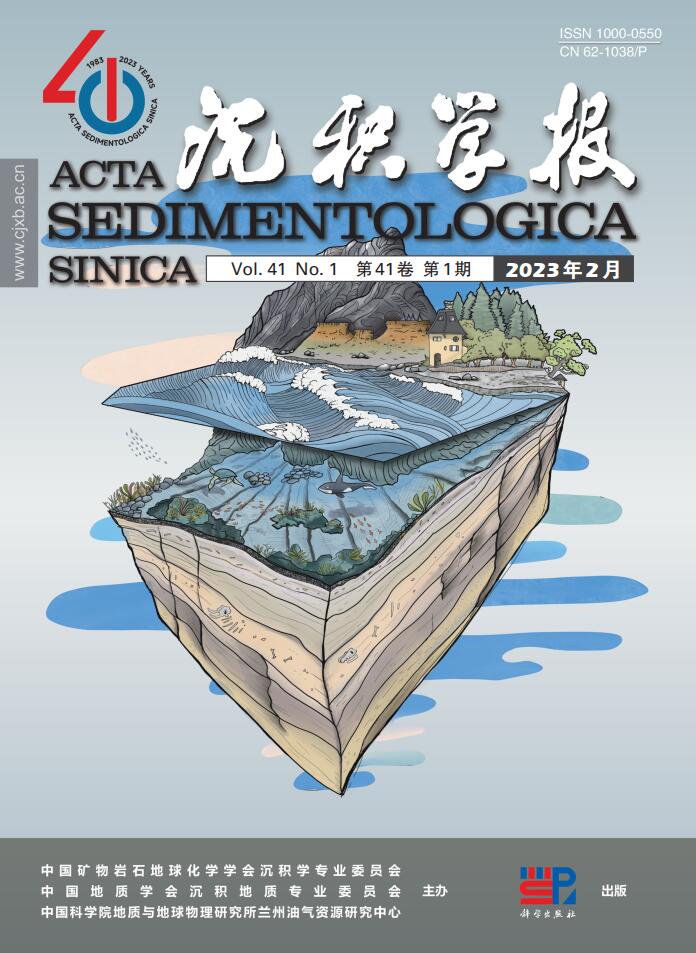


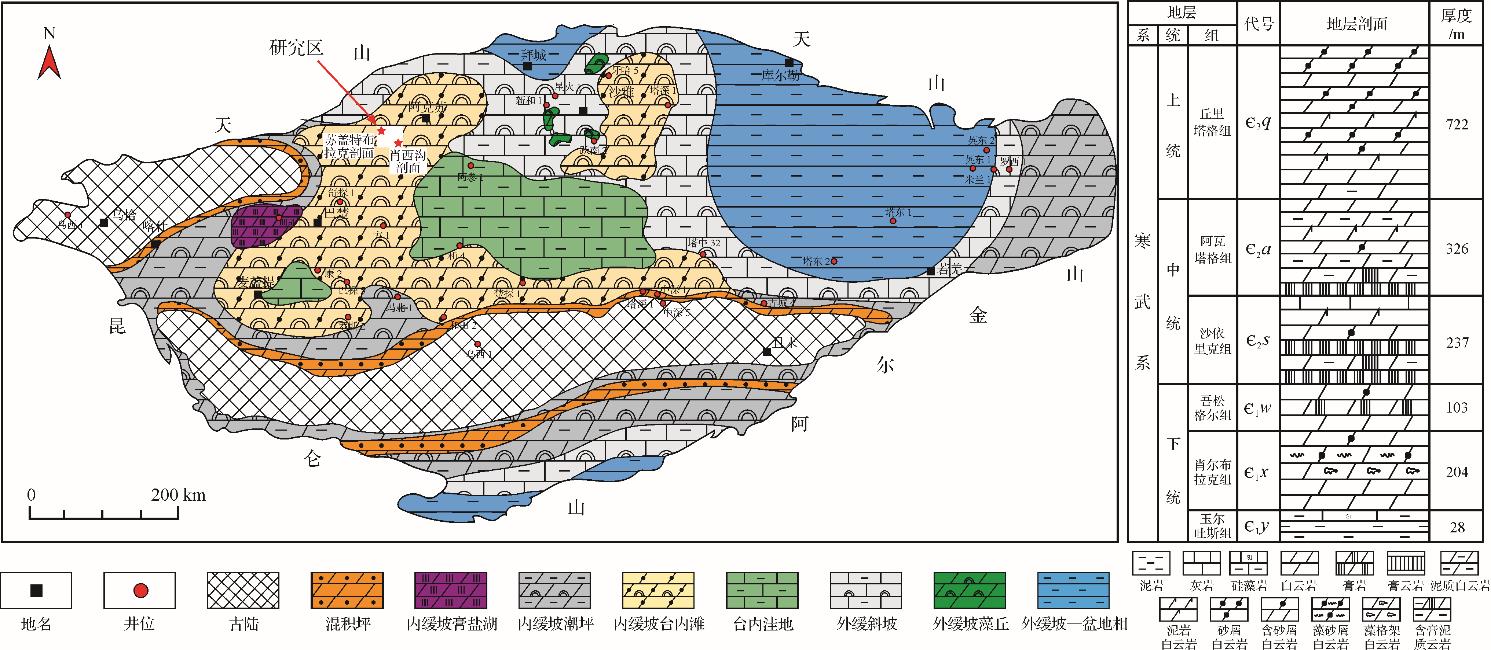










 DownLoad:
DownLoad:
